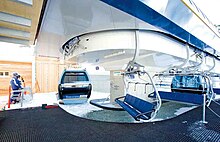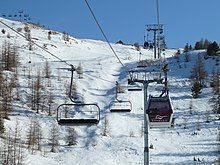




A hybrid lift is a type of ski lift that combines the elements of a chairlift and a gondola lift. First introduced by Poma, who refers to them as Telemix, they have since been built by most lift manufacturers who refer to them by a variety of names; Doppelmayr refers to them as a combined lift, Bartholet refers to them with the French name, téléporté mixte,[1] while the more generic terms chondola and telecombi are common in North America.
Both chairs and gondolas have advantages for lift operations. Gondolas offer protection from the elements and are particularly useful in rain or very cold conditions. They can also be used during the summer for walk-on guests, cyclists or wheelchairs, and in the winter for snowshoers. In the winter, gondolas require skiers and snowboarders to remove their equipment and walk into the cabin. Chairs are generally more convenient and easier to board for skiers. Some lifts have so-called 'bubble' chairs, which add a retractable acrylic glass dome to protect passengers from weather.
A hybrid lift allows cabins and chairs to be used on the same lift line, changing the ratio as the rider load, season and weather conditions demand. On most hybrid lifts, during the winter season there are usually more chairs than cabins, for example, the hybrid lift at Sunday River has 60 chairs and 15 cabins, with four chairs between each cabin. During the summer season, many hybrid lifts will operate with fewer chairs, or with gondola cabins only. Year-round versatility is increasingly important as ski resorts add summertime activities, such as downhill cycling and nature hiking trails.
To allow safe loading and unloading, stations have separate areas for the different carrier types. This may resembling a gondola station followed by a chairlift station, or vice versa – the overall length of the boarding area can be reduced by folding the station so that the gondolas are loaded on the "downhill" side of the ends of the lift, and the chairs on the uphill side. In some stations the cabins may use a separate contour.
- ^ "Téléporté Mixte". Bartholet. Retrieved 21 September 2020.